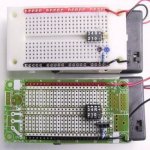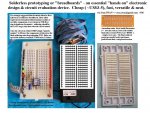I am looking for some decent prototype boards for mostly 14-m and 20-m, but where to look besides the picaxe show, which has a very limited selection ?
I would like (not everything has to be present on a surgestion)
Battery plug
DC adapter plug (with 7805)
Room for terminals on some/all in/outputs (does not need to be mounted, so components can be placed there instead)
Output buffer, and jumper to select if the buffer or direct pin goes to terminal
Room for resistor between pins and +/0V
Maybe some leds, buttons, dip switch, etc.
I have been thinking about making my own, but if someone already made the effort, I would rather just use those
It takes far too long for me to put finished breadboard ideas onto a finished vero board with wire and stuff.
Alternativly I can use a marker and hand draw some for etching, but it also takes a lot of time, and removes the fun from the project, since its already working...
I would like (not everything has to be present on a surgestion)
Battery plug
DC adapter plug (with 7805)
Room for terminals on some/all in/outputs (does not need to be mounted, so components can be placed there instead)
Output buffer, and jumper to select if the buffer or direct pin goes to terminal
Room for resistor between pins and +/0V
Maybe some leds, buttons, dip switch, etc.
I have been thinking about making my own, but if someone already made the effort, I would rather just use those
It takes far too long for me to put finished breadboard ideas onto a finished vero board with wire and stuff.
Alternativly I can use a marker and hand draw some for etching, but it also takes a lot of time, and removes the fun from the project, since its already working...


